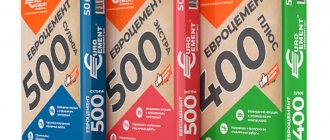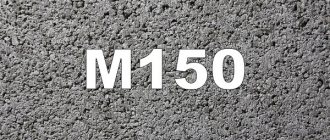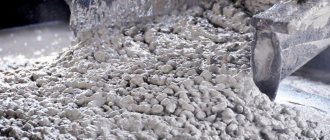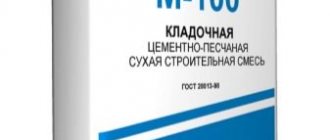Cement is used constantly in construction: they pour foundations or walls, use them for finishing work or to create load-bearing structures. When choosing a brand, you need to pay attention to the environment (temperature, humidity), what pressure the structure will experience, the rate of hardening, etc.
Cement D0 and D20 are often compared, the differences of which are not immediately noticeable. These two types are very different from each other in characteristics - in the second, 20% of the volume is occupied by impurities. But impurities are not always needed.
Source martand.ru
Scope of application
PC400 cement is a popular building material, which is used for finishing and construction of objects with high requirements for strength and frost resistance. For private construction purposes, this brand is rarely used, which is explained by the following factors:
- The setting speed of the heavy solution is quite high.
- Raw materials are expensive and have improved performance properties, which are often unnecessary.
In most cases, it is advisable to use more affordable brands if they meet the conditions of use. The main area of operation of the M400 is the arrangement of load-bearing structures that face heavy loads and withstand high stress.
Cement grade M400 is also used for the following tasks:
- Organization of load-bearing elements and critical objects.
- Construction of monolithic reinforced concrete buildings.
- Construction of hydraulic structures located in water with different characteristics and composition (salt, fresh, waste).
- Creation of high-strength bank vaults.
- Construction of overpasses, viaducts, bridges and overpasses.
- Arrangement of curbs, staircases and communication manifolds.
- Organization of important facilities in mining, engineering and other fields of activity.
M400 cement, whose technical characteristics correspond to a high class, is in demand for industrial use. When carrying out home construction work, including the arrangement of swimming pools or foundations for housing, the material is rarely used, which is associated with excessive strength properties.
Portland cement 400 is also characterized by such a feature as rapid hardening. This can be seen as both an advantage and a disadvantage. In the first case, concrete quickly gains factory strength and can be used within 8-10 hours from the moment of pouring, and in the second, installation without cold joints can only be done with the help of professional equipment and a team of specialists.
If this is not possible, the material will begin to crack and peel. To get rid of the problem, various additives are added to the feedstock, which increases the cost of the project. Therefore, PC 400 D20 cement is not suitable for private purposes.
Briefly about the main thing
Construction cannot be done without cement. The latter is available in various brands: they differ in characteristics and areas of application. At the same time, it is impossible to replace one brand with another: this can even lead to the destruction of the entire building if the chosen brand was not suitable for the situation.
When choosing concrete, I always look at the “D” designation. This letter indicates the percentage of additives contained in the material. Most often I need cement with certain properties, and I choose “D20”, but a couple of times I needed “pure” powder. Then I took bags of D0 concrete.
Question
Write in the comments if you use cement in your work? Which type are you using: for the foundation, walls or finishing?
Features and Benefits
Cement mortar M 400 is considered a popular subtype of cement, which consists of the following components:
- Gypsum.
- Powder clinker.
- A number of additional components.
To produce quality material, it is necessary to carefully monitor each process and evaluate the condition of all additives. In addition to the basic ingredients, modern Portland cement contains the following additives:
- calcium oxide;
- silica;
- alumina;
- iron oxide.
When clinker comes into contact with water, it creates new minerals that form cement stone. For convenient classification of the material, its purpose and specific composition are taken into account.
The following subtypes of grade 400 cement are available for sale:
- PC - Portland cement.
- GF is hydrophobic.
- SS - sulfate resistant.
- BC - white and colored mixtures.
- Slag Portland cement (SPC).
- Sand-cement mixture.
Among the key advantages of the M400 mixture are the following:
- Easy to use and no complications during breeding. To prepare a good solution, you need to follow the step-by-step guide.
- Cheap and accessible. Bags of M400 cement are sold in any construction hypermarket and market. The only difficulty is choosing the right manufacturer.
- Improved performance properties and load resistance. Even if deviations were made during the production of the material, the likelihood of cracking or deformation will be minimal.
- Wide temperature range at which operation is allowed without risk of damage. It varies from -60 to +300°C. This allows the brand to be used in a variety of directions.
- Minimal shrinkage during hardening. Due to this property, builders can change dimensions when pouring a foundation or arranging another structure. This indicator also eliminates the problem of cracks appearing on the surface.
- Fast setting and hardening. The interval during which the cement hardens takes 8-10 hours. At the same time, it takes no more than two to three weeks to gain factory strength. If the temperature rises or humidity changes, the curing time will be shortened.
- The ability to change the initial properties by introducing plasticizers, anti-corrosion additives and other substances into the composition.
Where is it used?
The difference between D0 and D20 is not only in characteristics - they are used in different jobs. The scope of application of cement is quite extensive. Depending on the type and composition, it is used when pouring foundations, floors, walls and ceilings, in plaster mortar, as plaster and decorative coating, when sealing cracks, etc. The scope of application largely depends on its compressive strength. The higher it is, the more pressure concrete can withstand, the stronger and more reliable it is, the longer its service life.
The following grades of concrete are used:
- M400 D0. It has high frost resistance, but the rate of hardening and deformation during shrinkage are average. Concrete is used in private construction in the construction of prefabricated and monolithic structures, as well as in industrial construction.
Source webflow.com
- M500 D0. It has high frost resistance and strength. Scope of application: large industrial facilities, bridges, airfield runways. It is also used for restoration work.
- M400 D20. It has average performance in all respects: hardening speed, frost resistance and shrinkage deformation. It is used to create structures made of cement.
- M500 D20. It has average frost resistance and hardening. It is used for casting monolithic structures, as well as in individual construction and finishing.
The cost of D0 and D20 cements is different: “clean” concrete is more expensive than the brand.
You can find out how GOST standards have changed and what cement grades are now called in the video
Specifications
Cement M400 D20 has a number of technical characteristics that distinguish it from other solutions. The general parameters look like this:
- The compressive strength after 28 days of exposure corresponds to 39.2 MPa. 1 cm3 of such concrete can withstand loads of up to 400 kg.
- The density of M400 cement is determined by the size of the clinker and the type of additives in the composition. The specific gravity of cement varies from 1000 to 1200 kg/m³ in bulk form. A compacted solution can weigh up to 1700 kg/m³, and a moistened solution can weigh at least 3 tons.
- Hardening. The setting process begins after 2 hours, and the set of factory strength properties (up to 98%) occurs after 28 days.
- Resistance to exposure to aggressive environments with exposure to sulfates is low. To improve this indicator, PC D 20 cement with slag additives and other additives is added to the feedstock.
- Grinding grain size. Notifies about the specific surface area of particles contained in 1 kg of dry cement. The average varies from 3000 to 3200 kg/m³. The lower the value, the stronger the material will be after curing.
- The degree of frost resistance corresponds to class F100. This standard indicates the number of freeze and thaw cycles that the stone can withstand. The exact indicators are determined by the composition and ratio of the components. Alite and sulfate-resistant mixtures have the greatest frost resistance.
- Density. Notifies about the required volume of liquid for hardening in proportion to the dry mixture. The average varies from 22-28%.
- Heat dissipation. Indicates the degree of heat generation in case of hydration. If the material is subjected to uneven cooling or heating, it can become covered with cracks and deformations.
- Temperature range - from -60 to +300°C.
- Resistant to moisture. To make the material completely waterproof, it is enriched with sealing additives and waterproofing agents.
What cement is used in semi-dry screed:
To prepare a high-quality semi-dry screed solution, we often use Portland cement M500 / 400 D0 - CEM I / CEM II, with this we can achieve the strength of the floor screed from M150 to M200+ grade strength depends on the amount of cement in the mortar.
How much cement is needed for a concrete semi-dry floor screed?
To obtain a high-quality solution of a semi-dry floor screed, the composition of cement in relation to sand is from ¼ to 1/6, where one part of cement and 4 or 6 parts of sand, this ratio depends on the requirement for the brand strength of the floor screed 1/6 we approximately get the M150 grade, and with proportions of ¼ we can get grade M200+
How much cement is needed for a classic floor screed?
Unlike a semi-dry screed where the ratio of cement and sand in the solution is ¼ and 1/6, this ratio is used to ensure that the semi-dry screed does not crack since the cement takes up a significant part of the moisture, and in a semi-dry screed there is a minimal amount of it, but unlike a semi-dry one a classic screed is covered with a large amount of water and the ratio of sand to cement is 1/3 and the strength of the finished screed will be M300, but this type of screed is highly susceptible to shrinkage when hardening.
Production
CPS is a binder based on crushed clinker with a standardized composition. There is a GOST 10178-85 standard, according to which the content of magnesium oxide and the proportions of other ingredients are selected.
Organic minerals are used as feedstock, such as:
Using firing technology, clinker is created from this raw material. The main substance is combined with mineral additives that affect the final properties of the working mixture and stone.
For industrial purposes, plasticized subtypes of cement are created, which are characterized by increased fluidity and guarantee improved compaction when constructing concrete structures. The mixture contains clinker and gypsum, as well as an active additive. This can be a concentrate of sulfite and alcohol, containing 0.2% of the total weight of M400 cement.
The material differs from other varieties in its improved resistance to frost, corrosion and stress.
Marking
Brand M400 is a general designation for a binder. A full description is given in GOST 10178-85, where the following indicators may be mentioned:
- PC is Portland cement based on alite clinker.
- 400 - marking for resistance to compression loads.
- D20 - characterizes the mineral content as a percentage.
- B - degree of hardening.
- PL - presence and function of additives. In this case, the mixture is plasticized.
- GF is a hydrophobized mixture.
New marking of M400 mixtures
Most Russian manufacturers of cement mixtures are guided by the marking described above, but leading companies consider it outdated and use a new method from the European Union:
- CEM. The marking indicates the complete purity of Portland cement and the absence of additives in its composition.
- CEMII. Characterized by the presence of slag additives. Taking into account their concentration, two varieties are distinguished: class “A” (contain 6-20% slag), class “B” (contain 20-35% slag raw materials).
Since 2003, cement manufacturers have been practicing this European standard, additionally specifying parameters such as hardening time and performance properties.
Source










